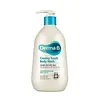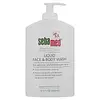What's inside
What's inside
 Key Ingredients
Key Ingredients

No key ingredients
 Benefits
Benefits

 Concerns
Concerns

 Ingredients Side-by-side
Ingredients Side-by-side

Water
Skin ConditioningCocamidopropyl Betaine
CleansingSodium Cocoyl Alaninate
Lauryl Glucoside
CleansingSodium Lauryl Glucose Carboxylate
CleansingTrihydroxystearin
Skin ConditioningPotassium Cocoyl Glycinate
Potassium Cocoate
EmulsifyingSodium Sweetalmondamphoacetate
CleansingChamaecyparis Obtusa Water
MaskingPanthenol
Skin ConditioningVitis Vinifera Seed Oil
EmollientButyrospermum Parkii Butter
Skin ConditioningMyristoyl/Palmitoyl Oxostearamide/Arachamide Mea
Skin ConditioningPhytosterols
Skin ConditioningCaprylic/Capric Triglyceride
MaskingCetearyl Alcohol
EmollientLecithin
EmollientSorbitan Stearate
EmulsifyingGlyceryl Stearate
EmollientStearic Acid
CleansingButylene Glycol
HumectantXanthan Gum
EmulsifyingGlycol Distearate
EmollientPolyquaternium-7
Sodium Chloride
MaskingHexylene Glycol
EmulsifyingCitric Acid
BufferingSodium Citrate
BufferingDisodium EDTA
1,2-Hexanediol
Skin ConditioningCaprylyl Glycol
EmollientSodium Benzoate
MaskingUndecylenic Acid
CleansingParfum
MaskingWater, Cocamidopropyl Betaine, Sodium Cocoyl Alaninate, Lauryl Glucoside, Sodium Lauryl Glucose Carboxylate, Trihydroxystearin, Potassium Cocoyl Glycinate, Potassium Cocoate, Sodium Sweetalmondamphoacetate, Chamaecyparis Obtusa Water, Panthenol, Vitis Vinifera Seed Oil, Butyrospermum Parkii Butter, Myristoyl/Palmitoyl Oxostearamide/Arachamide Mea, Phytosterols, Caprylic/Capric Triglyceride, Cetearyl Alcohol, Lecithin, Sorbitan Stearate, Glyceryl Stearate, Stearic Acid, Butylene Glycol, Xanthan Gum, Glycol Distearate, Polyquaternium-7, Sodium Chloride, Hexylene Glycol, Citric Acid, Sodium Citrate, Disodium EDTA, 1,2-Hexanediol, Caprylyl Glycol, Sodium Benzoate, Undecylenic Acid, Parfum
Water
Skin ConditioningSodium C14-16 Olefin Sulfonate
CleansingSodium Laureth Sulfate
CleansingDisodium Laureth Sulfosuccinate
CleansingSodium Chloride
MaskingLaureth-2
CleansingPanthenol
Skin ConditioningGlycol Distearate
EmollientParfum
MaskingSaccharide Isomerate
HumectantAllantoin
Skin ConditioningNiacinamide
SmoothingPyridoxine Hcl
Skin ConditioningGlycine
BufferingMagnesium Aspartate
Skin ConditioningAlanine
MaskingLysine
Skin ConditioningLeucine
Skin ConditioningBiotin
AntiseborrhoeicGlycerin
HumectantSodium Lauroyl Glutamate
Sodium Citrate
BufferingCocamidopropyl Betaine
CleansingSorbitan Laurate
EmulsifyingPEG-120 Methyl Glucose Dioleate
EmulsifyingPhenoxyethanol
PreservativePotassium Sorbate
PreservativeSodium Benzoate
MaskingCI 47005
Cosmetic ColorantCI 42090
Cosmetic ColorantWater, Sodium C14-16 Olefin Sulfonate, Sodium Laureth Sulfate, Disodium Laureth Sulfosuccinate, Sodium Chloride, Laureth-2, Panthenol, Glycol Distearate, Parfum, Saccharide Isomerate, Allantoin, Niacinamide, Pyridoxine Hcl, Glycine, Magnesium Aspartate, Alanine, Lysine, Leucine, Biotin, Glycerin, Sodium Lauroyl Glutamate, Sodium Citrate, Cocamidopropyl Betaine, Sorbitan Laurate, PEG-120 Methyl Glucose Dioleate, Phenoxyethanol, Potassium Sorbate, Sodium Benzoate, CI 47005, CI 42090
Alternatives
Ingredients Explained
These ingredients are found in both products.
Ingredients higher up in an ingredient list are typically present in a larger amount.
Cocamidopropyl Betaine is a fatty acid created by mixing similar compounds in coconut oil and dimethylaminopropylamine, a compound with two amino groups.
This ingredient is a surfactant and cleanser. It helps gather the dirt, pollutants, and other impurities in your skin to be washed away. It also helps thicken a product and make the texture more creamy.
Being created from coconut oil means Cocamidopropyl Betaine is hydrating for the skin.
While Cocamidopropyl Betaine was believed to be an allergen, a study from 2012 disproved this. It found two compounds in unpure Cocamidopropyl Betaine to be the irritants: aminoamide and 3-dimethylaminopropylamine. High-grade and pure Cocamidopropyl Betaine did not induce allergic reactions during this study.
Learn more about Cocamidopropyl BetaineGlycol Distearate serves as a pearlizing or opacifying agent in cosmetic products.
It's often included in cleansers and haircare products to give them a lustrous or shimmering appearance.
It is derived from stearic acid, a natural fatty acid commonly found in vegetable oils and animal fats.
Glycol Distearate isn't fungal acne safe.
Learn more about Glycol DistearatePanthenol is a common ingredient that helps hydrate and soothe the skin. It is found naturally in our skin and hair.
There are two forms of panthenol: D and L.
D-panthenol is also known as dexpanthenol. Most cosmetics use dexpanthenol or a mixture of D and L-panthenol.
Panthenol is famous due to its ability to go deeper into the skin's layers. Using this ingredient has numerous pros (and no cons):
Like hyaluronic acid, panthenol is a humectant. Humectants are able to bind and hold large amounts of water to keep skin hydrated.
This ingredient works well for wound healing. It works by increasing tissue in the wound and helps close open wounds.
Once oxidized, panthenol converts to pantothenic acid. Panthothenic acid is found in all living cells.
This ingredient is also referred to as pro-vitamin B5.
Learn more about PanthenolParfum is a catch-all term for an ingredient or more that is used to give a scent to products.
Also called "fragrance", this ingredient can be a blend of hundreds of chemicals or plant oils. This means every product with "fragrance" or "parfum" in the ingredients list is a different mixture.
For instance, Habanolide is a proprietary trade name for a specific aroma chemical. When used as a fragrance ingredient in cosmetics, most aroma chemicals fall under the broad labeling category of “FRAGRANCE” or “PARFUM” according to EU and US regulations.
The term 'parfum' or 'fragrance' is not regulated in many countries. In many cases, it is up to the brand to define this term.
For instance, many brands choose to label themselves as "fragrance-free" because they are not using synthetic fragrances. However, their products may still contain ingredients such as essential oils that are considered a fragrance by INCI standards.
One example is Calendula flower extract. Calendula is an essential oil that still imparts a scent or 'fragrance'.
Depending on the blend, the ingredients in the mixture can cause allergies and sensitivities on the skin. Some ingredients that are known EU allergens include linalool and citronellol.
Parfum can also be used to mask or cover an unpleasant scent.
The bottom line is: not all fragrances/parfum/ingredients are created equally. If you are worried about fragrances, we recommend taking a closer look at an ingredient. And of course, we always recommend speaking with a professional.
Learn more about ParfumSodium Benzoate is a preservative. It's used in both cosmetic and food products to inhibit the growth of mold and bacteria. It is typically produced synthetically.
Both the US FDA and EU Health Committee have approved the use of sodium benzoate. In the US, levels of 0.1% (of the total product) are allowed.
Sodium benzoate works as a preservative by inhibiting the growth of bacteria inside of cells. It prevents the cell from fermenting a type of sugar using an enzyme called phosphofructokinase.
It is the salt of benzoic acid. Foods containing sodium benzoate include soda, salad dressings, condiments, fruit juices, wines, and snack foods.
Studies for using ascorbic acid and sodium benzoate in cosmetics are lacking, especially in skincare routines with multiple steps.
We always recommend speaking with a professional, such as a dermatologist, if you have any concerns.
Learn more about Sodium BenzoateChances are, you eat sodium chloride every day. Sodium Chloride is also known as table salt.
This ingredient has many purposes in skincare: thickener, emulsifier, and exfoliator.
You'll most likely find this ingredient in cleansers where it is used to create a gel-like texture. As an emulsifier, it also prevents ingredients from separating.
There is much debate on whether this ingredient is comedogenic. The short answer - comedogenic ratings don't tell the whole story. Learn more about comegodenic ratings here.
The concensus about this ingredient causing acne seems to be divided. Research is needed to understand if this ingredient does cause acne.
Scrubs may use salt as the primary exfoliating ingredient.
Learn more about Sodium ChlorideSodium Citrate is the sodium salts of citric acid. In skincare, it is used to alter pH levels and acts as a preservative.
Its main functions are to maintain the pH of a product and neutralize metal ions.
The acidity of our skin is maintained by our glands and skin biome; normal pH level of skin is slightly acidic (~4.75-5.5).
Being slightly acidic allows our skin to create an "acid mantle". This acid mantle is a thin barrier that protects our skin from bacteria and contaminants.
Learn more about Sodium CitrateWater. It's the most common cosmetic ingredient of all. You'll usually see it at the top of ingredient lists, meaning that it makes up the largest part of the product.
So why is it so popular? Water most often acts as a solvent - this means that it helps dissolve other ingredients into the formulation.
You'll also recognize water as that liquid we all need to stay alive. If you see this, drink a glass of water. Stay hydrated!
Learn more about Water